There are so many places to visit in Hampi that you could spend months here exploring them all. However, since most of us don’t have that much time on our hands, here’s bringing you the best places to see and things to do in Hampi that you can easily shortlist for a 3-4 days trip. In that duration, you’ll probably be able to see most of these sites at a fast pace. If you want to take it slower, just choose the ones you like the most based on the images of Hampi’s attractions and their history.
If you’re planning a trip to Hampi, you might also like to check out our detailed Hampi travel guide that not only has a solid itinerary covering the majority of the below mentioned Hampi tourist places but also tells you about how to get there, when to visit, where to stay and other tips.
Can’t travel there? Well, then just enjoy these photos of Hampi. Travelling virtually is all the rage in these times anyway.
The Best Temples in Hampi
There are a plethora of temples in Hampi of which 11 are mentioned overall in this blog post in different sections. In this particular section we are covering the major or unique temple complexes.
Vitthala Temple
Vitthala Temple is the grandest temple in Hampi and a must add to your list even if you’re visiting for just a day. Built in the 15th century, it is dedicated to Vittala, an incarnation of Lord Vishnu. The temple exemplifies the creativity and architectural excellence of the artisans and sculptors of the Vijayanagara empire. The highlights of this temple are The Stone Chariot (details below) and the musical pillars that when tapped produce musical notes. It’s a marvel that these single blocks of stone can emit perfect notes!
Pro-Tip: Visit the temple first thing in the morning (8:30 AM) to avoid the crowd. Also, hire a guide.
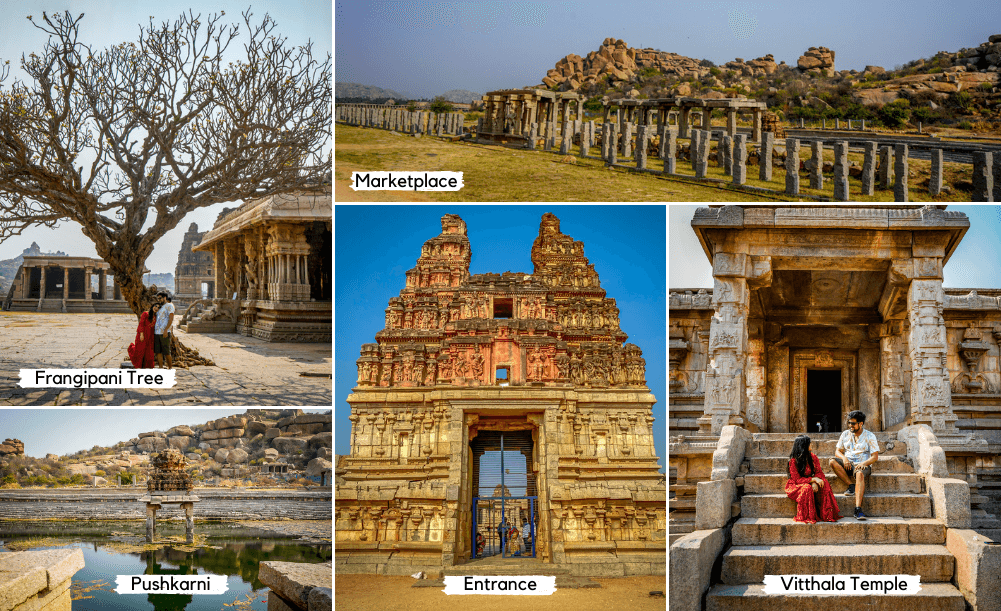
The Stone Chariot of Hampi
The stone chariot of Hampi is very popular not only because of its visual charm but also because it is featured on the INR 50 currency note. Swipe the Instagram post below to see what we are talking about.
That said, there is much to know about this iconic structure and slightly deceptive chariot.
- It is not a chariot but actually a shrine in the shape of one. The shrine is dedicated to Garuda, the vehicle of Lord Vishnu to whose incarnation the temple is dedicated.
- The chariot shrine might look like a carved monolith but it is actually built of large blocks of granite. The joints are smartly hidden in the carvings.
- It is inspired by the chariot shaped Konark Sun Temple in Orissa – a magnificent structure that the king of the empire was greatly impressed by. And so was I!
Fun Fact: There is a third famous chariot located in Mahabalipuram in Tamil Nadu!
Hazara Rama Temple
Constructed in the 15th century, the Hazara Rama temple is the only temple located in the royal centre of Hampi. The temple, as the name suggests, is dedicated to Rama – an incarnation of Lord Vishnu. The walls of this small temple have carved on them the story of the Hindu epic Ramayana in a comic strip form. These relics are among the most extensive ones to be found anywhere in India. Another highlight of the temple are the black marble pillars that are unlike any others in Hampi.
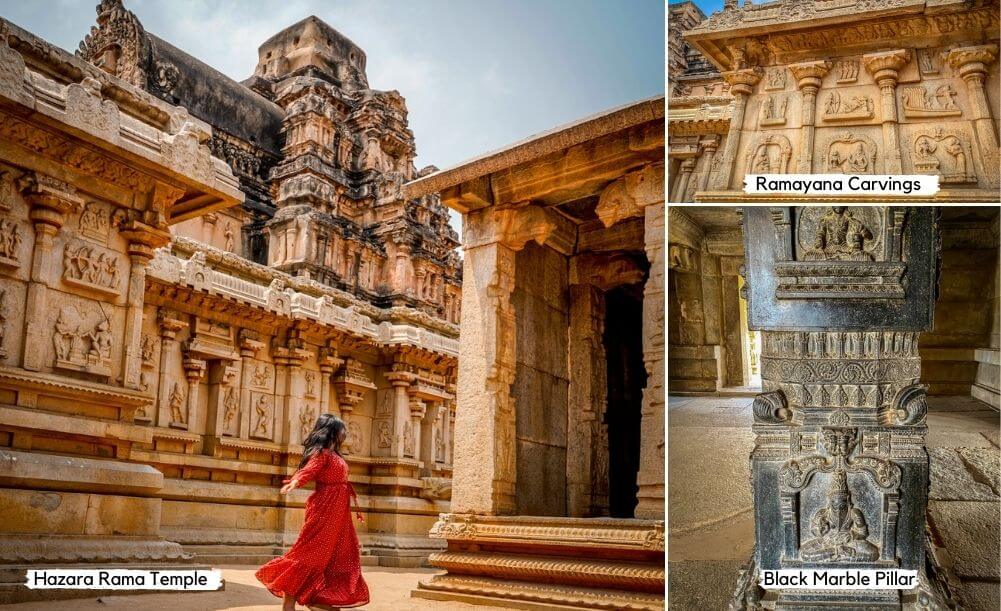
Virupaksha Temple
Located in the main Hampi area, Virupaksha temple is the most popular temple in Hampi. Why so? Well firstly, it is the only working temple in Hampi. Secondly, it is a 7th-century temple so it is the oldest known temple in Hampi. And lastly, it is also home to a cute elephant called Lakshmi that gives blessings (pictured below).
The main things to see in the temple are the 11 storeyed golden gopuram, the inner courtyard, vegetable paint paintings on the roof of the main temple, a hole in a chamber that works like a pinhole camera casting the shadow of the gopuram on a wall, the serene well (or kund), and also monkeys and squirrels.
Pro-Tip: To see Lakshmi being bathed you can visit the Tungabhadra river at 8 AM. Also, Lakshmi is taken away from the temple at about 5:30 AM-6:00 AM so ensure you meet her before that.
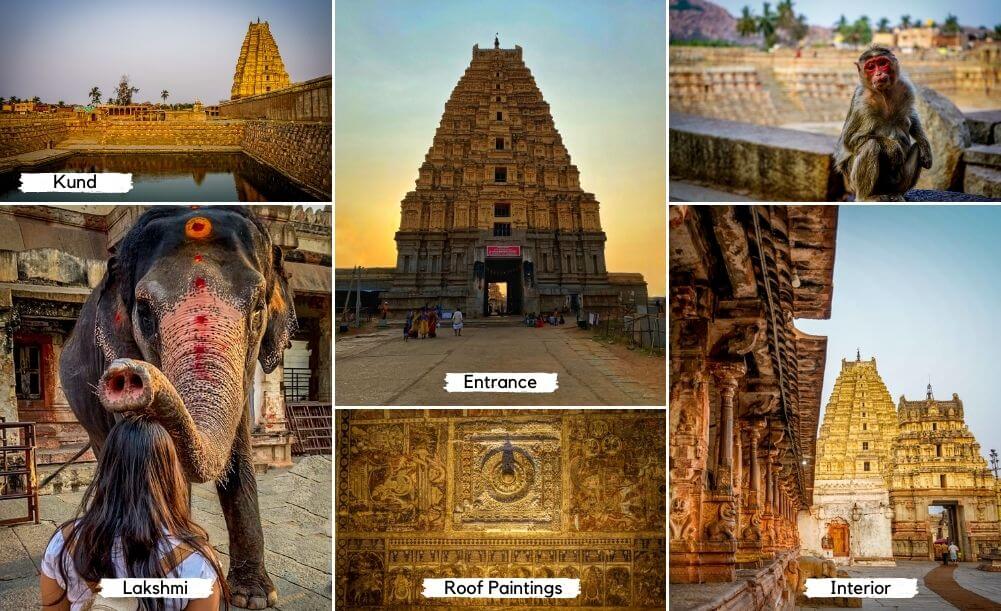
Achyutaraya Temple
Located next to Matanga hill, Achyutaraya Temple is in a somewhat hidden location and hence seldom visited. Most temples in Hampi you see today were built in the 15th century. Since this was constructed by a high officer in King Achyuta Raya’s court in the 16th century, it is one of the last temples constructed before the fall of the Vijayanagara Empire.
The temple is dedicated to Tiruvengalanatha – an incarnation of Lord Vishnu. The pillars, towers and walls have exquisite carvings. Despite major parts of the temple being in ruins, it does not fail in grandiosity.
Pro Tip: Visit this temple around midday as leopards have been spotted here in the evening even at 5 PM.
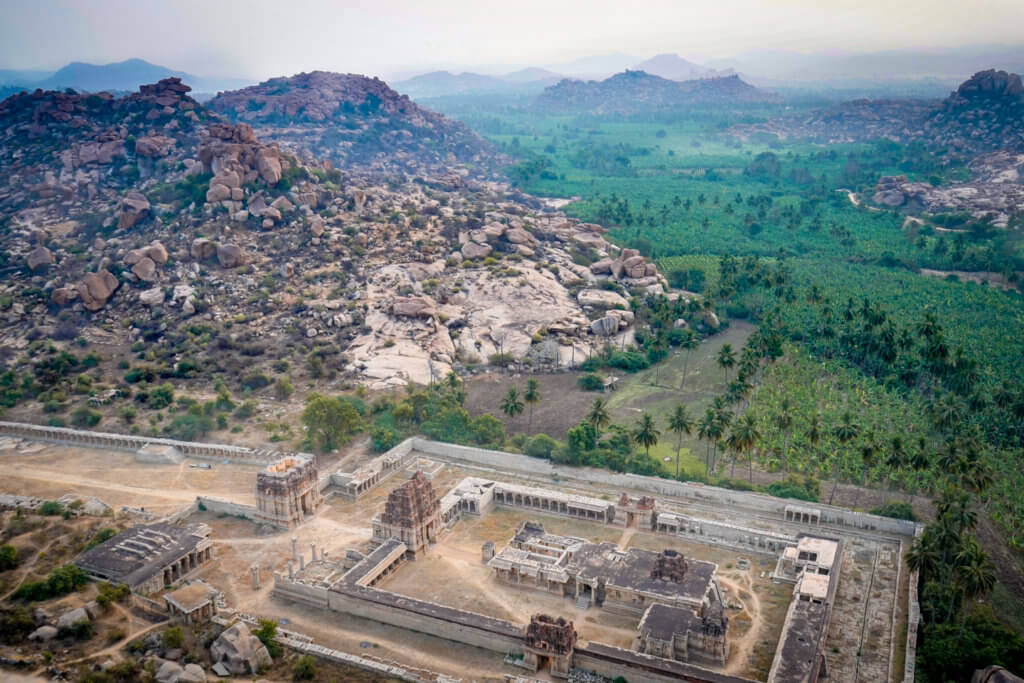
Underground Shiva Temple
The Prasanna Virupaksha Temple, dedicated to Lord Shiva in his avatar as Virupaksha, is located underground. It is one of the older temples in Hampi having been built in the 14th century but interestingly it was discovered only in the 1980s. Because of its location close to the nobleman’s quarters, it is believed that the temple was used for private ceremonies by the royals. After visiting so many temples with exquisite carvings, it is almost refreshing to visit one that is so simple and yet so unique. The area surrounding the temple has a beautiful lawn you can relax on or picnic.
Pro-Tip: Since the temple is underground, it is often submerged in water. The temple, therefore, cannot be visited in the monsoon months from June to September. In other months, you may still find a bit of water in the temple.
Another famous temple in Hampi is the Krishna Temple. You can include it in your itinerary if you have time. We will be covering notable statue temples and others below so read on!
Amazing Royal Monuments in Hampi
These monuments in Hampi are located in the Royal Centre that houses the palaces, durbars, tanks, residences, and baths used by the royals of the empire.
Lotus Mahal
The Lotus Mahal (also known as Kamal Mahal or Chitragani Mahal) is located inside a walled space called the Zenana Enclosure which was used by the women of the royal family. There is nothing to be seen of other buildings in the enclosure as they are heavily damaged. However, the Lotus Mahal is an absolute charmer with its unique lotus bud domes. It is built in Indo Islamic style – the arches of the palace are build in Islamic style and the multi-layered roof design is Indo style.
It is worth noting that all the structures built in Indo-Muslim or Muslim style are in better condition than those that were built in pure Hindu style. This is because when the combined armies of the Muslim rulers of the Deccan attacked Hampi, they only damaged Hindu style structures. So most temples were burnt but such royal structures left intact. However, the structures have anyway deteriorated due to improper maintenance and the wrath of time.
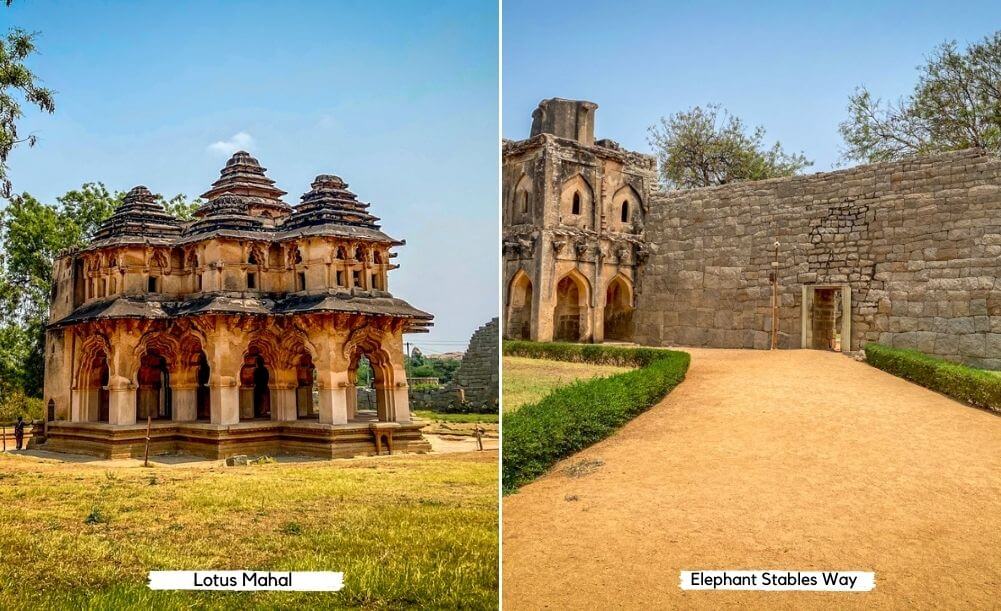
Elephant Stables
These stables located right behind Zenana Enclosure (route pictured above on the right) is a beautiful one built in Indo-Islamic style! It used to house the elephants of the royals back in the day. The structure tells us two things. Firstly, a lot of importance was given to elephants in the Vijaynagara Empire; such a beautiful structure was built to shelter them. Secondly, the building shows the secularism of the Empire since the domes of the stable are built in Hindu, Islamic and Jain styles.
We personally enjoyed our visit here immensely. It is great for photography and also for chilling by the shade of the tree and inside the stables.
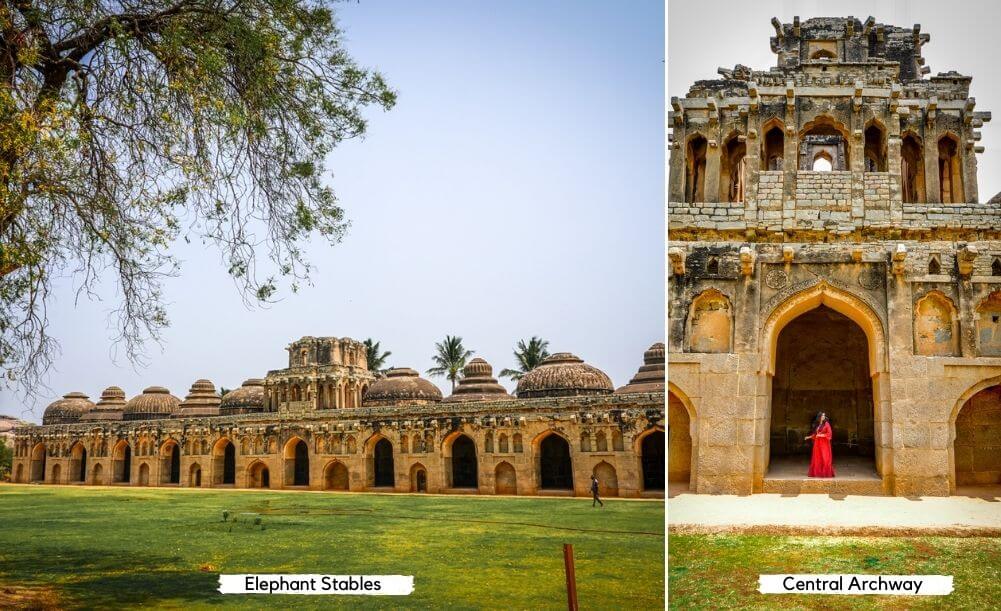
Stepped Tank
There are many tanks, kunds or pushkarnis in Hampi. These were built mainly near temples for ritual cleansing before prayers, cleansing of idols and/or to store water during dry months.
This tank located in the royal enclosure is totally different from other tanks of Hampi as it is constructed using finely finished blocks of black schist stones. Built for the royals for religious purposes, it is about 22 square meters in size and 7 meters deep with 5 tiers. The symmetry, colour and design of the structure are simply mesmerizing.
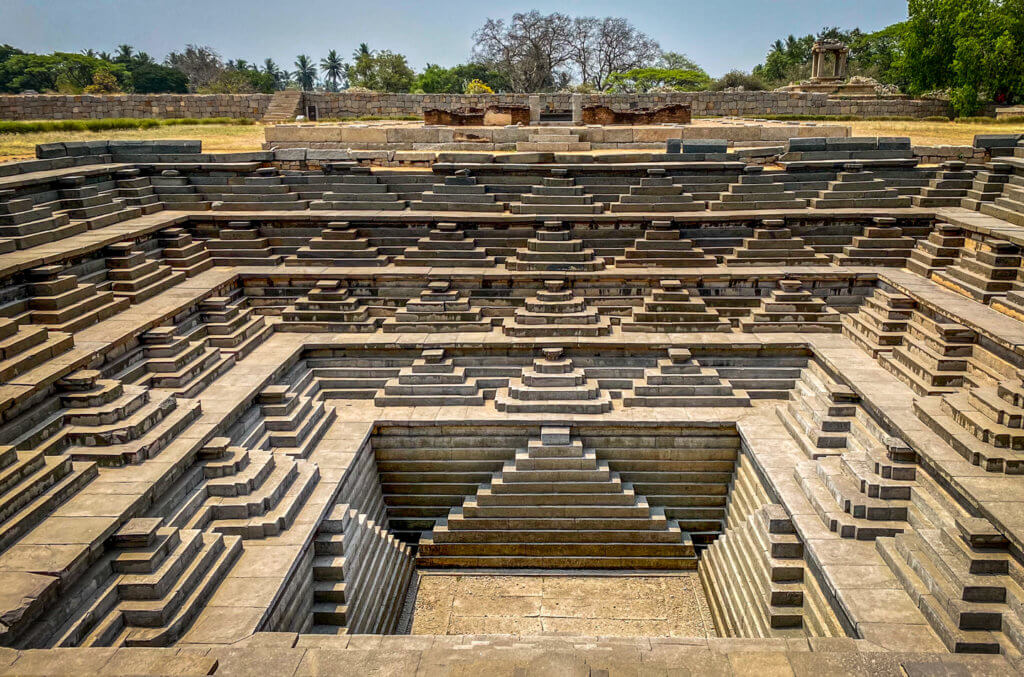
Mahanavami Dibba
Also known as The Great Platform, it is a 3-tiered 8-meter high platform used by the king to watch Dussehra/Maha Navami celebrations. The bottom tier of the platform has interesting war carvings etched on its surface. Since the Dibba is the only structure that stands as is in the Royal Enclosure, you can see a vast expanse of empty land in front of it.
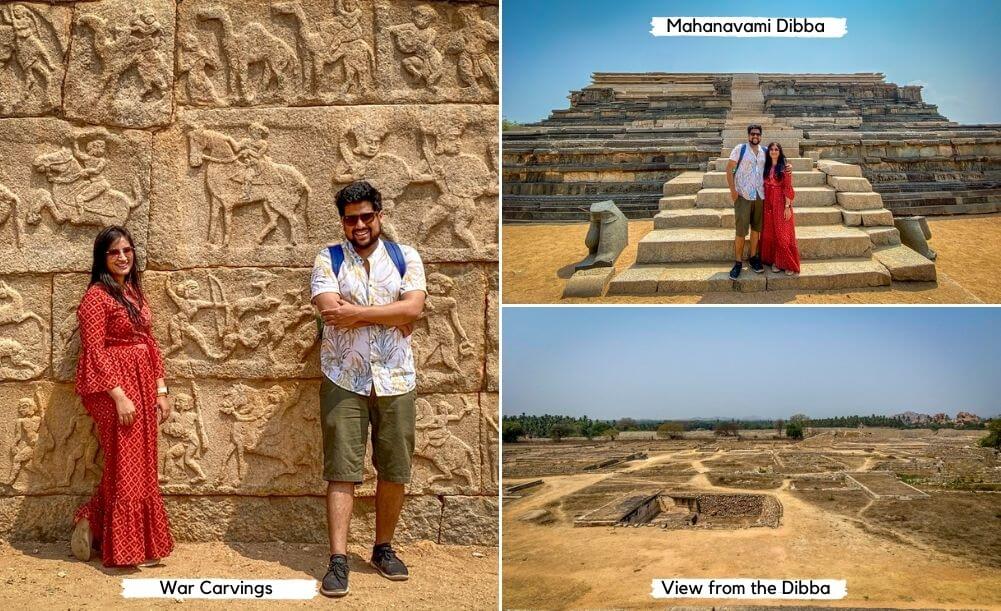
Queen’s Bath
The Queen’s Bath, as the name suggests, was a bath for the queen and other royal women. However, due to its location away from buildings in royal enclosure, it is also often believed to have been a pleasure palace. This 14th-century building doesn’t look like much from the outside as the building is flat and architecture simple. But on the inside, it is super picturesque. The interior is surrounded by consecutive archways and ornate balconies with a sunken 1.8 meters deep empty bath in the centre. You will often find an owl or owlets in the bath – a visual cherry on the cake!
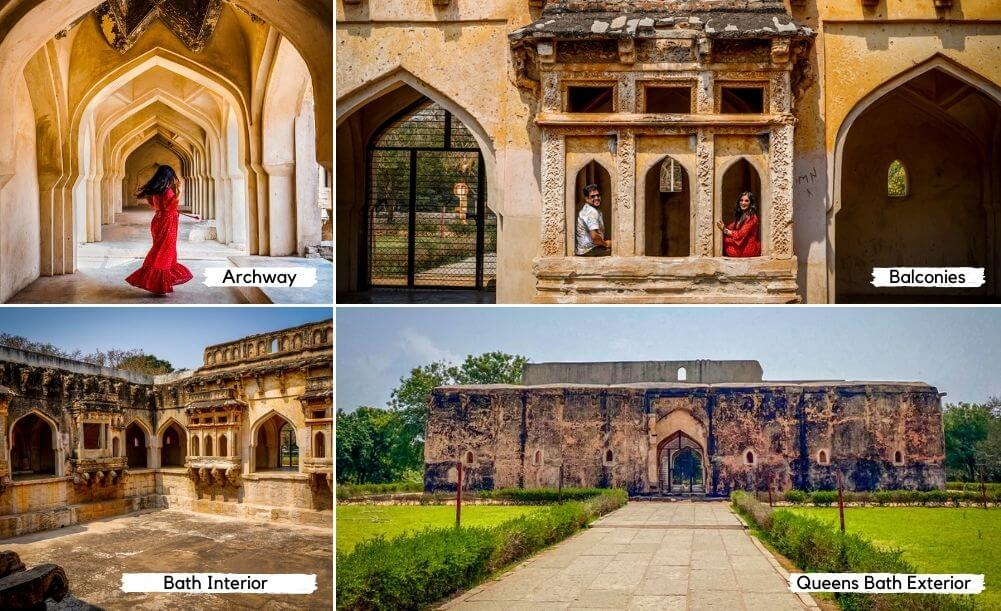
Magnificient Monolith Statue Temples in Hampi
Hampi has grand monolithic statue temples that are simply mind-blowing. Imagine people of that time, moving such large blocks of stone and sculpting it.
Lakshmi Narasimha Temple
This temple is dedicated to Narasimha, a lion-faced avatar of Lord Vishnu, and Goddess Lakshmi as well who was his consort. It is the largest monolith statue in Hampi at 6.7 metres– an imposing sight! And definitely our favourite monolith in Hampi!
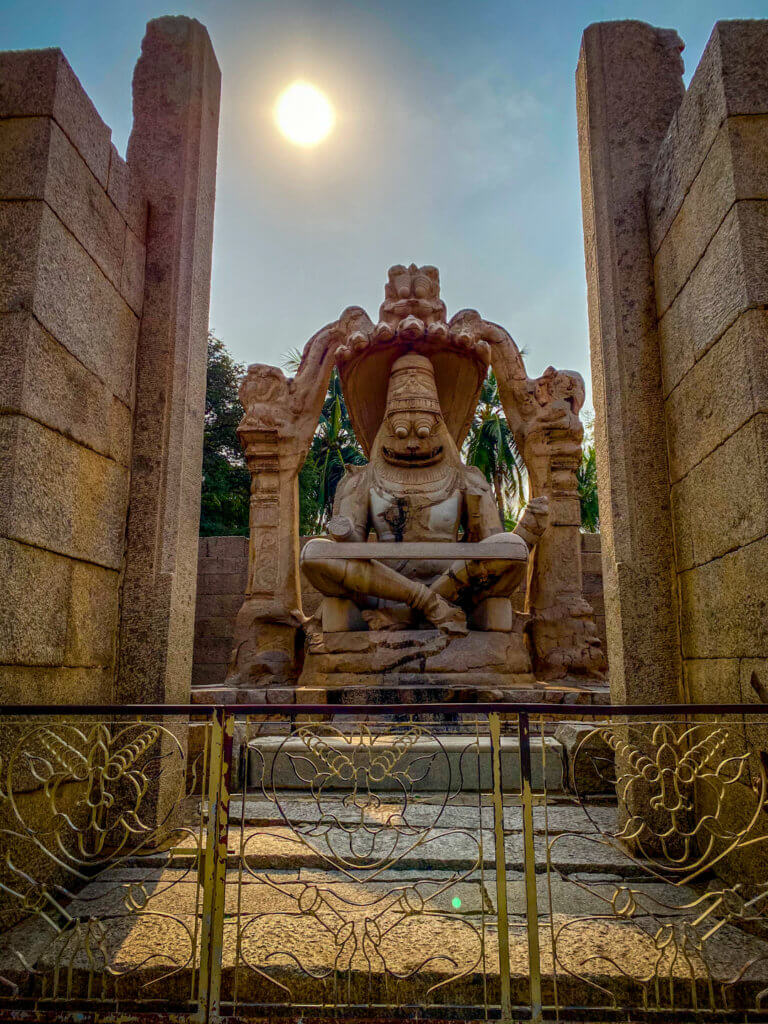
Kadalekalu Ganesh
Located on Hemakuta Hills, the Kadalekalu Ganesha is a 4.6-meter statue, the belly of which resembles a Bengal gram (Kadalekalu in local language). The statue is in a sanctum inside a beautiful stone structured temple decorated with tall and ornate granite pillars in the front. This Ganesha statue was built for and frequented by the royal family.
The temple is located on high ground so you can get an amazing view of the Hampi Bazaar and the foothills of Matanga Hill. The entire setting is very serene and you may even find a cool breeze flowing through the temple.
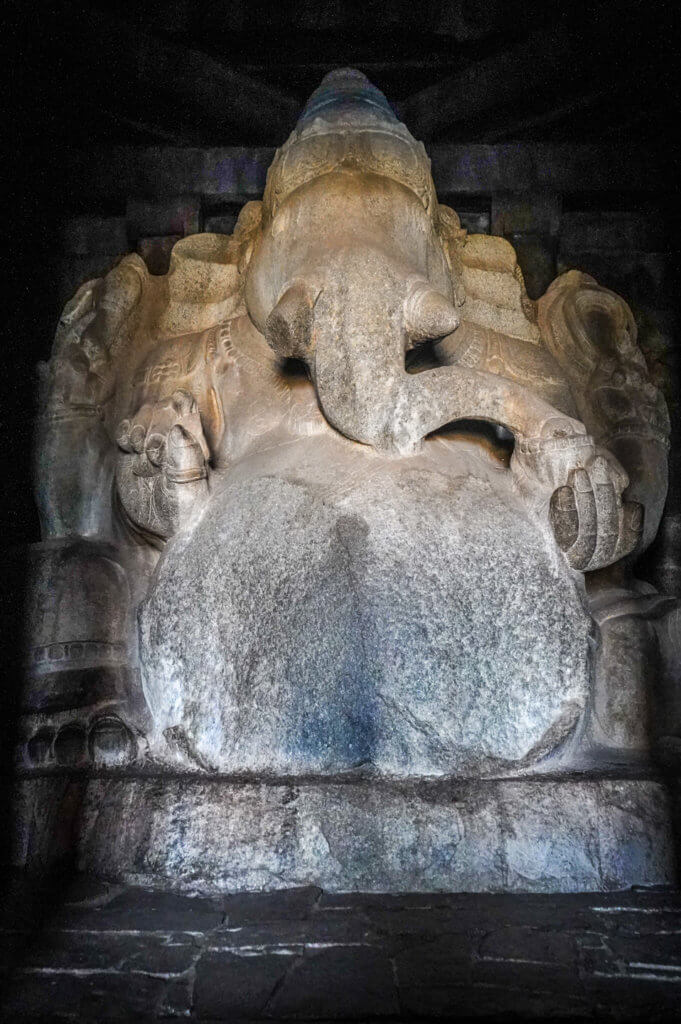
Monolithic Bull
Also known as Yeduru Basavanna or Nandi, this monolithic bull is located at one end of the Virupaksha Bazaar. This statue of the mount of Lord Shiva symbolically faces the Virupaksha Temple also dedicated to Shiva. Though the statue is carved in a coarse style and is also partially mutilated, this Nandi attracts tourists owing to its giant size (also because it’s in the vicinity of other attractions). The surroundings of the bull statue are quite pleasing to the eye. See for yourself in the pictures below.
Pro-Tip: No need to make a seperate visit to this statue. Visit is on the way to Achutaraya Temple or the Tungabhadra River (coracle ride).
Sasivekalu Ganesha
Sasivekalu Ganesha is a 2.4-metre high statue of Ganesha that was built for the common people of the kingdom. The statue of Ganesha depicts a snake tied around the waist. Per Hindu mythology, Lord Ganesha once ate a lot of food and had to tie a snake around his stomach to prevent it from bursting. The statue is also called Mustard Ganesha as the Ganesha’s belly is shaped like a mustard seed. Unlike the Kadalekalu Ganesha, this statue is placed in an open pavilion.
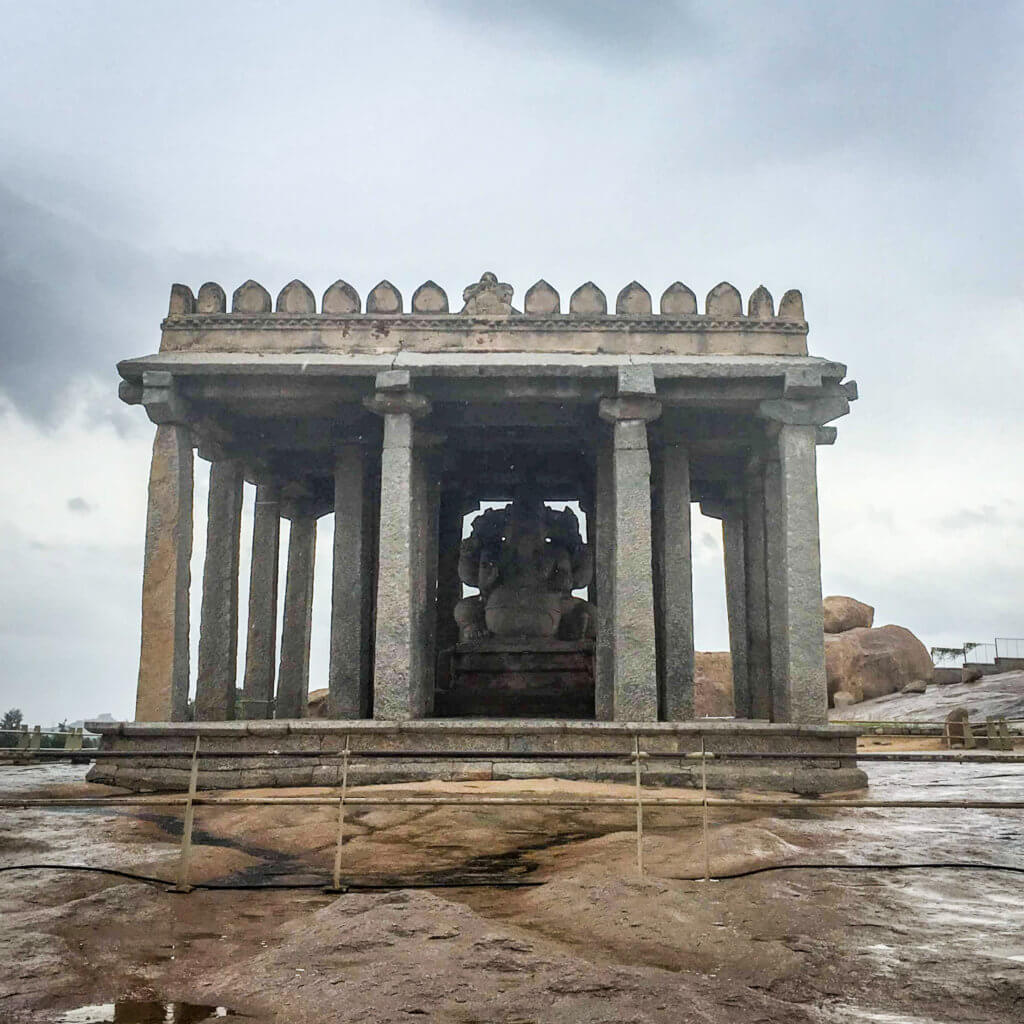
Badavilinga Temple
Located a few steps away from the Narasimha Statue is this giant shrine for Shiva. At 3 metres, it is the largest Linga in Hampi and is made of impressive black stone. The Linga sanctum is always filled with water as a water canal flows through it. It is believed that the statue was commissioned by a peasant woman and hence the name (The word Badva means poor in the local language).
Pro Tip: No need to plan a visit this statue on a seperate visit since it is located beside the Narasimha statue!
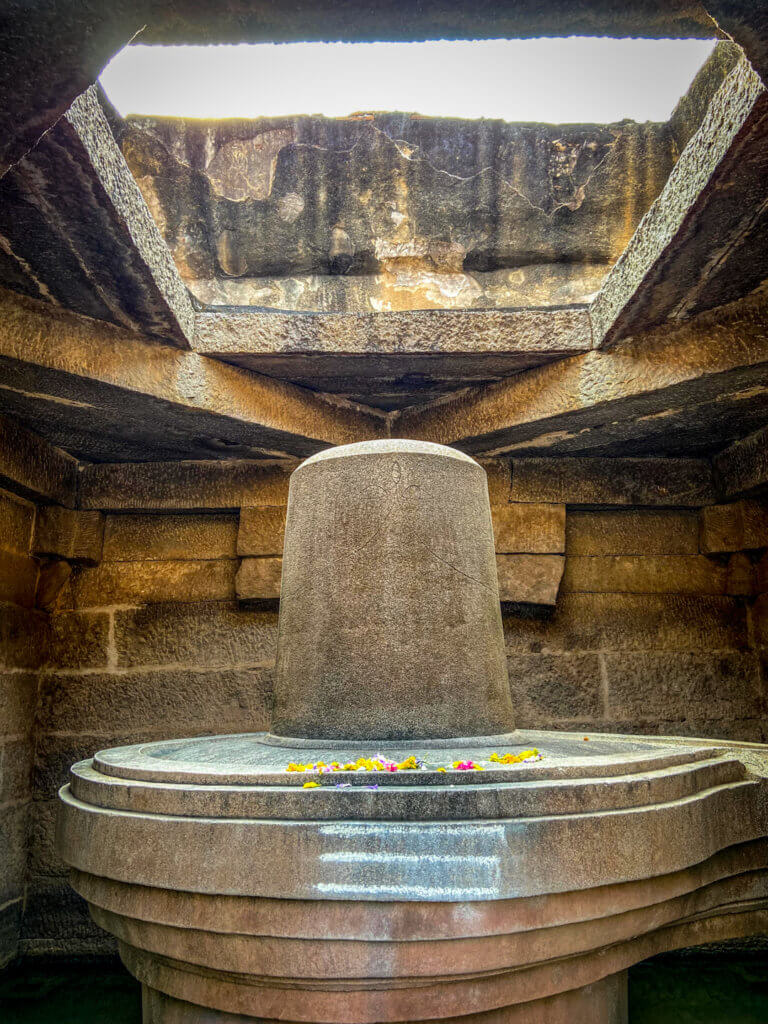
Places to Visit in Hampi for Sunrise and Sunset
Sunrises and sunsets in Hampi are spectacular due to the incredible surrounding landscape. Sure sunrises are more effort, but they’re so worth it in Hampi. Do not miss seeing at least one!
Hemakuta Hills
The Hemakuta hill temple complex is our favourite place to visit in Hampi. Why? You could just loiter here without any aim but still immensely enjoy the ruins, the huge boulders, the views from this vantage point, and not to mention the incredible sunset. Located beside the Virupaksha temple, these hills are easy to access and walk around. The most famous temples to visit here (besides the two Ganesha statues mentioned above) are the Hanuman Temple and the Moola Virupaksha temple which are within walking distance from the Virupaksha Temple. To watch the sunset, sit on either the benches at sunset point or anywhere else you like. We watched it while sitting on the stone railings of a temple! The sunset was breath-taking.
Pro Tip: The sun sets much above the horizon in Hampi because of the haze in the area. Do settle down much before sunset time to not be surprised when you find no sun in the sky!
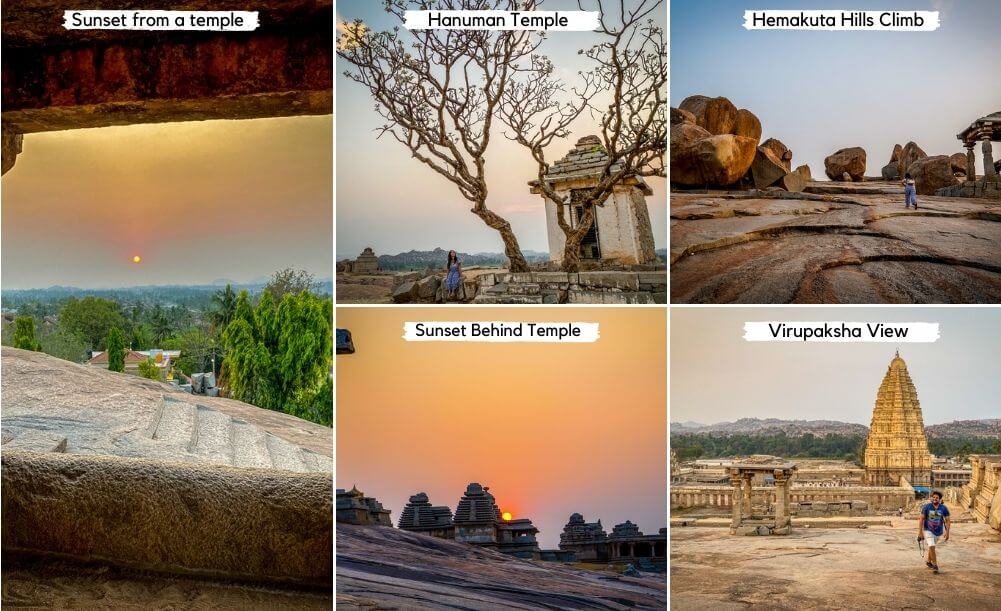
Matanga Hill
Climb the highest point of Hampi, Matanga Hill, for 360-degree surreal sunrise views. You’ll see multiple hues in the sky, boulder scattered terrain, Hemakuta Hills with all its temples, Virupaksha Temple, Achutaraya Temple, paddy fields till the eyes can see, and mountains in the distance. You might also be shown a cave on your way up – it is believed that Sugriva, ruler of Kishkinda, used to hide here. Yes, the hill is referenced in the Ramayana. There is also a small temple at the top which is dedicated to Veerbhadra – a form of Lord Shiva. The hike is a 40-minute steep one but awesome enough to not be missed. An alternate and easier route is taken to come down which takes you through short steps.
Pro-Tip: Firstly, hire a guide since the path is not defined, steep, and exposed in some areas. Secondly, don’t do this hike at sunset as bears have been spotted at the easy route after dark. You do not want to take the tougher route to come down as you’re more likely to injure yourself.
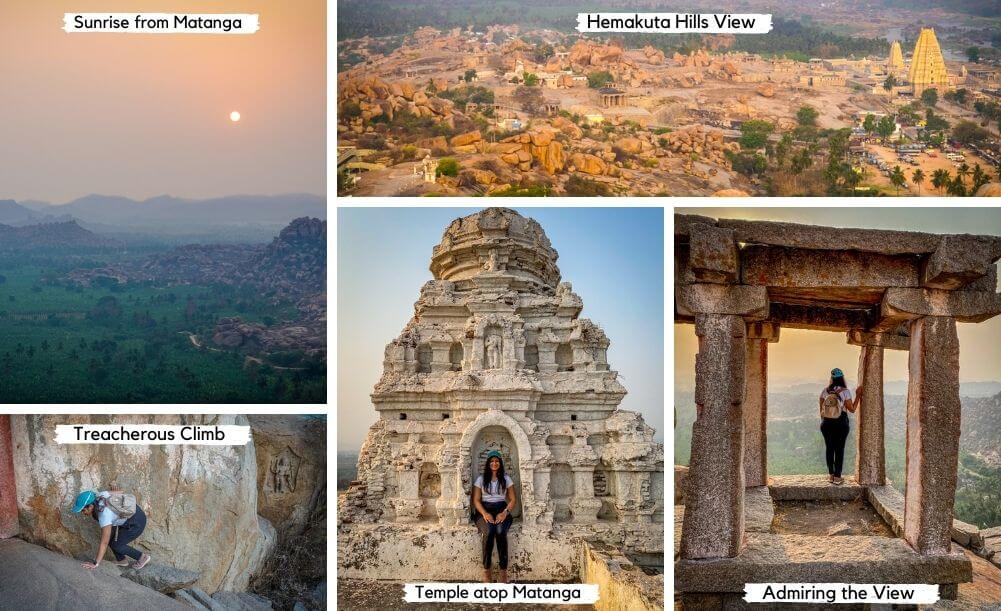
Tungabhadra River
Hampi is located on the banks of the Tungabhadra river. You can sit on the stones at the bank during sunset. You might not get a clear view of the sun but the evening time here has such a special vibe. But before that, go for a coracle ride in the river. This isn’t your typical boring boat ride, no! It is a ride on a round boat through the canyon of sorts. You’ll have stacked boulders hills on both sides that are dotted with temples (some are even half-submerged). It is an unforgettable sight! Definitely one of the best things to do in Hampi.
Pro-Tip: You may not be able to visit here and do the coracle ride in the monsoon months from June- September as the water levels rise greatly and the current is strong. To do a coracle ride in the monsoons, try Sanapur Lake. Also, it is better to do the coracle ride in the evening as this area is shaded from the sun at the time.
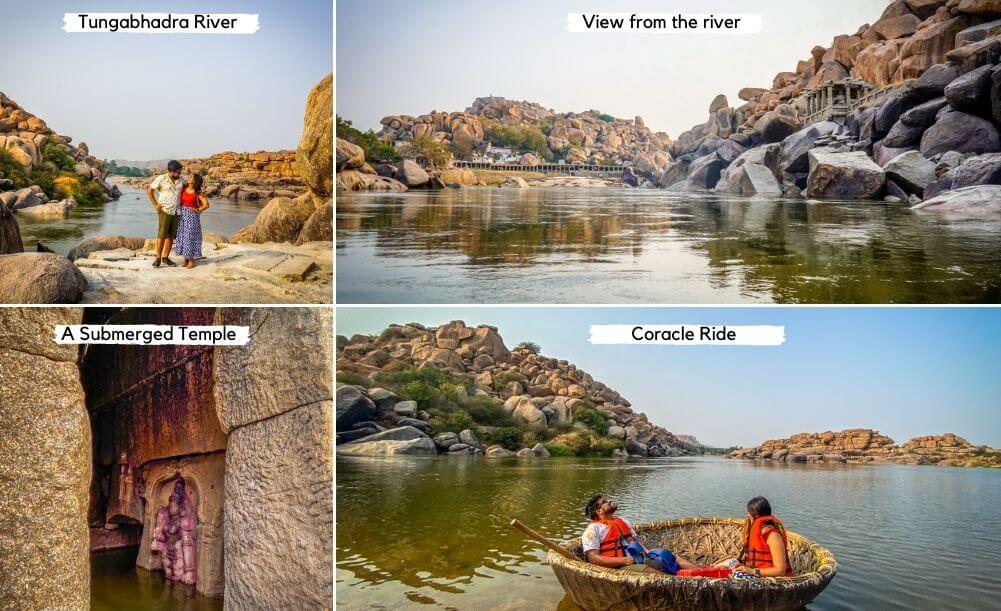
Kamalapur Lake
This was a chance find on a drive from Hampi to our hotel in Kamalapur. Most people including local guides don’t mention it. I don’t know why not – maybe it’s because of a bit of plastic waste you see discarded on the banks.
However, the sunset here is worth an evening. There are benches too for you to sit on and gaze at the sun in comfort and peace. We opened a packet of snacks and some beverages while watching the sun dip into the horizon. It was perfect!
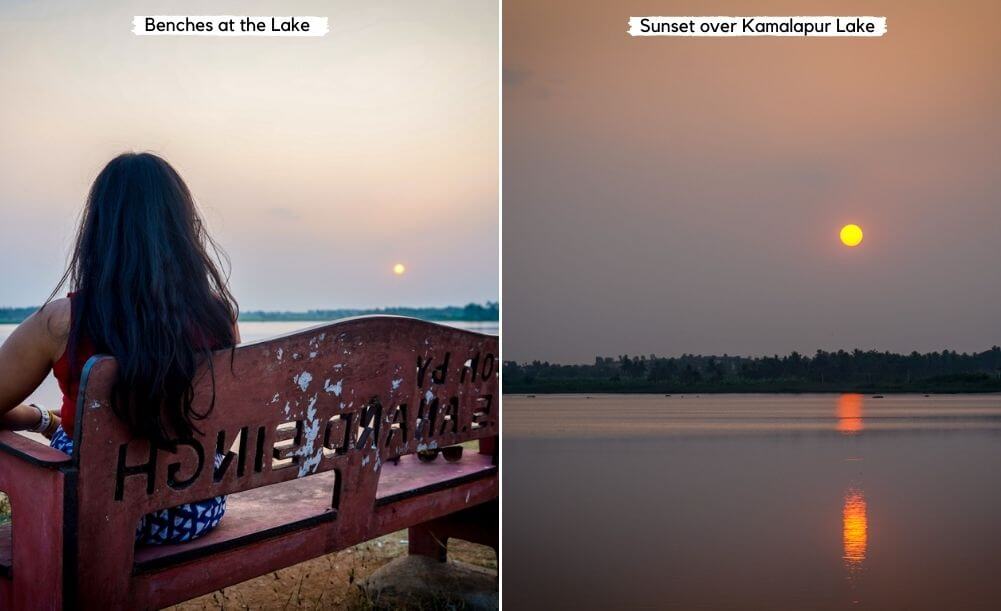
Anjaneya Hill
Anjaneya hill is a bouldered one located on the other side of the Tungabhadra river at Hanumanahalli. This 1-2 hour climb is a pilgrimage for most as this hill is the place where Lord Hanuman was born. As a result, the path is very well defined and shaded to make it easier for devotees to offer their prayers at the hilltop Hanuman temple. Check the sunset time on google and start your hike up well in time to be able to explore the temple and see a spectacular sunset from the top!
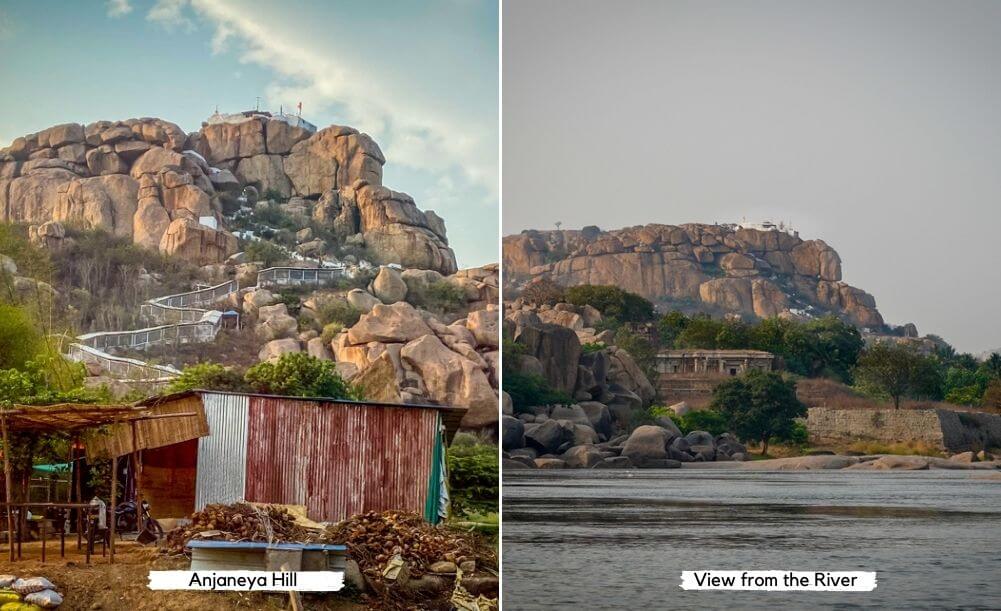
Places to Visit Near Hampi
Sandur
Sandur is a small mining town located about 40 kilometres from Hampi. It has a beautiful landscape characterized by rugged blue-black mountains and narrow lanes through lush fields (also gorgeous sunflower fields). The WelcomHertitage Shivavilas Palace Hotel located here used to be the residence of the King of Sandur. Now it is a 5-star hotel that is a museum in itself the common rooms have been left as-is from the time that the royal family lived here. The library, billiards rooms, vintage cars and living rooms – all take you back in time. This is definitely one of the best places to visit near Hampi.
Paddy Fields on the other side of the Tungabhadra River
When you’re in Hampi, people will refer to the area on the opposite bank of the Tungabhadra river as exactly that – the other side. This area covers villages like Hanumanahalli, Hippie Island (now bulldozed), Anegundi (where apparently most of Hippie Island has relocated after the bulldozing), and Sanapur. The drive around this area has the most picturesque paddy fields. Take a stroll around them or hire a bike (may be available during season time between October-February) and explore the area.
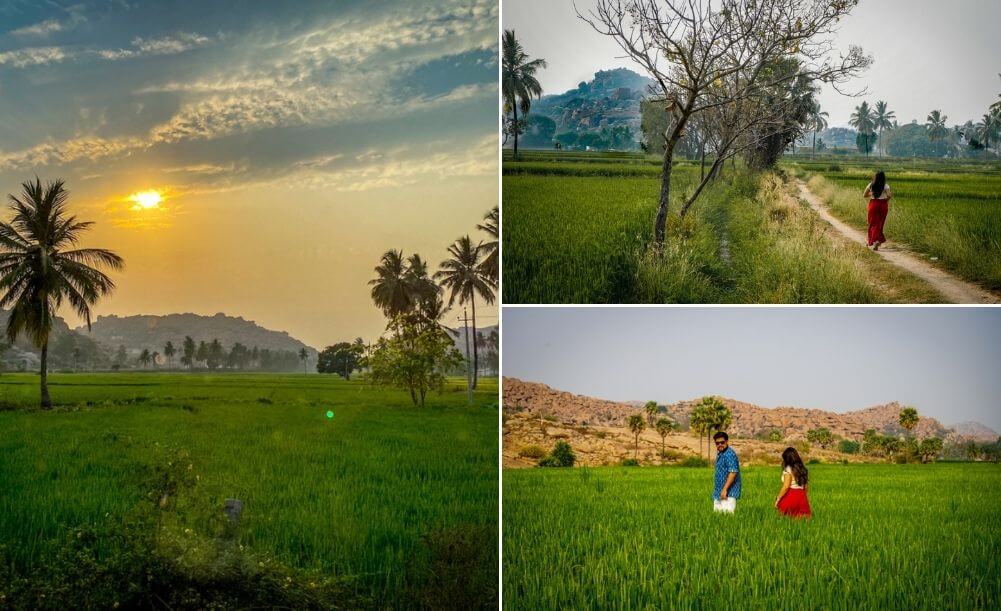
Temples and Sites Beyond the River
These are temples and attractions on the other side of the Tungabhadra river. This area was known as Kishkinda – the mythical kingdom of monkey kings Bali and Sugriva, mentioned in the epic Ramayana. Hence, most of these sites have religious importance!
- Anjaneya Hill: Birthplace of Hanuman. Mentioned above.
- Chinthamani Temple in Anegundi: Chintamani Temple is a Shiva Temple. It is the spot from where Ram aimed and shot his arrow to kill Baali during his fight with Sugriva. The temple is worth a visit by all due to its epic location beside the Tungabhadra.
- Pampa Sarovar Temple: The temple is constructed where Pampa (a form of Parvati) punishes herself to show her dedication to Shiva. Also, Pampa Sarovar is a sacred lake for Hindus – one of the 5 sacred lakes (Panch Sarovar) in Hindu mythology. If you’re not into mythology, consider visiting only from November to December when lotuses are in full bloom at Pampa Sarovar Lake.
- Anegundi Fort: The Anegundi fort with its many gates, tombs and temples (Ganesha Cave Temple and Durga Temple) is a sprawling fort that once used to guard the region.
- Gagan Mahal: Gagan Mahal, once the abode of rulers in the Vijayanagar Empire, is now a local administrative building that is not properly maintained. You can still check it out from the outside if you’re in the area.
Pro-Tip: Eat lunch at Baba Cafe. This café is reminiscent of the Hippie Island days as it has a similar vibe. Due to its awesome location in nature, the cafe makes for a great place to have some beer and international fare.
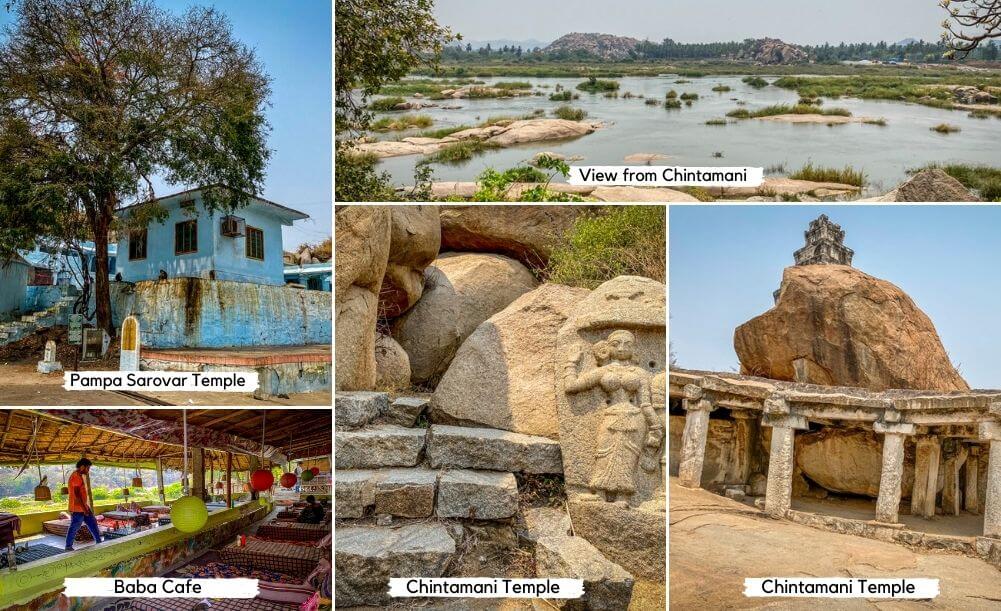
Tungabhadra Dam
The Tungabhadra Dam, 18 km from Hampi, is a nice short stopover on your route to or back from Hampi. The sheer volume of water it handles is a sight to see.
The dam has a well-maintained Japanese garden located beside it which is great for a picnic or a leisurely stroll. You might also like to visit when the dam’s gates are lit in rainbow colours in the evening between 7:15 to 8:30 PM.
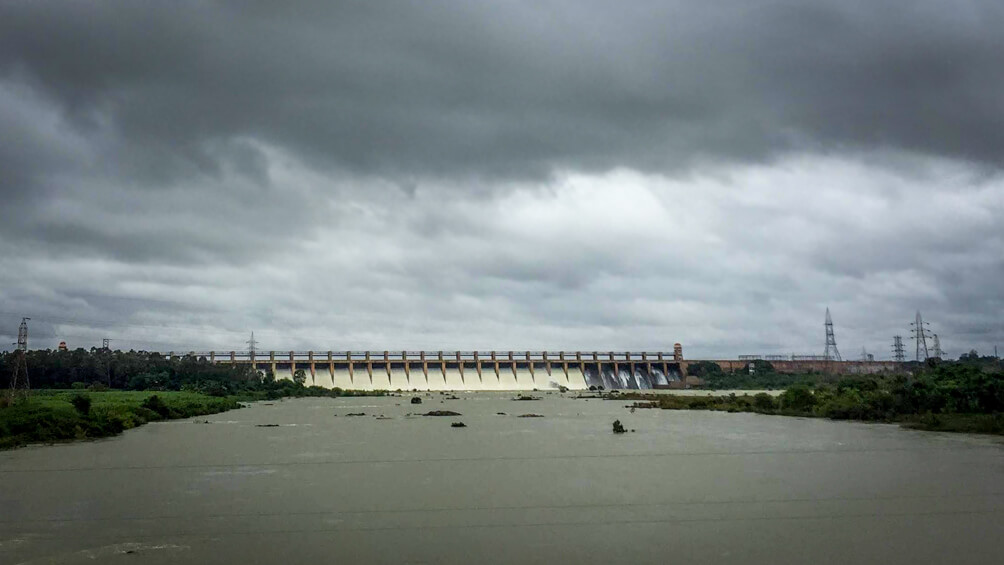
Sanapur Lake
Sanapur Lake located beyond Anegundi on the ‘other side of the river’, is an irrigation reservoir. It is less frequented due to its distance from Hampi and as per us, the lack of much to do here. It used to be THE spot for cliff climbing but as per locals, this has been banned as people have died after jumping in the lake. If you’re interested in cliff jumping, ask the locals if you actually can do that when you get there. Besides that, you can enjoy a coracle ride here (for much less money than at the Tungabhadra river) but overall the ride pales in comparison to the Tungabhadra one – no cliffs, no ancient temples, nothing. The best reason to visit here is the peace, since you’ll hardly find tourists in the area.
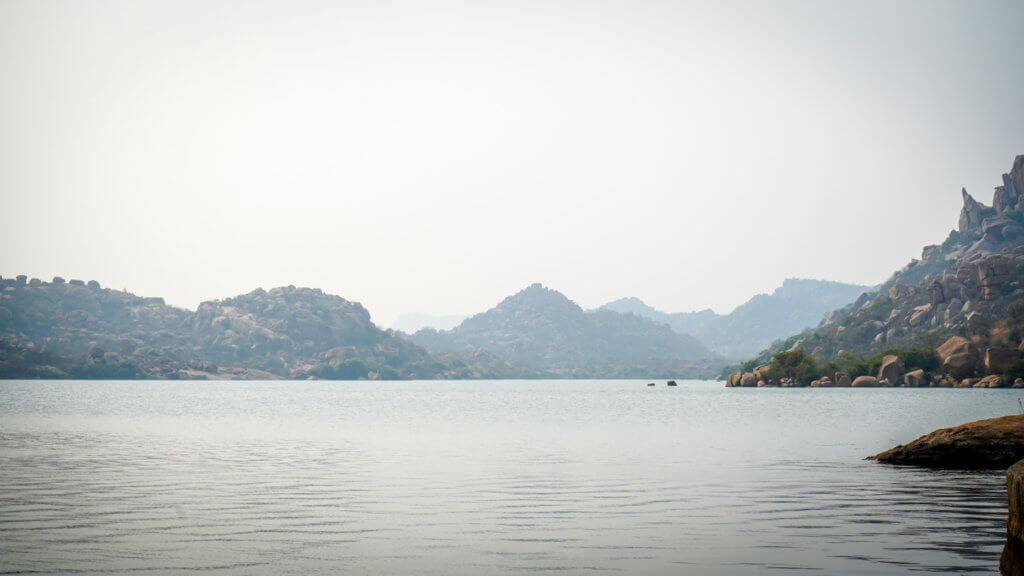
Points to Note
Opening and Closing Time: Most attractions open at 8:30 AM-9 AM. We suggest starting your day at the opening time to make the most of it. You can always return to your hotel in the afternoon from 1 PM-4 PM to rest as it gets too hot to explore. Also, it is better to exit most of Hampi’s attractions at or before sunset, to be safe from wild animals like bears and leopards.
Entrance Fees: Only a few attractions have entrance fees – Virupaksha temple with a cost of Rs.25 and Vitthala Temple at Rs. 40. The prices mentioned are for Indian nationals, BIMSTEC and SAARC country nationals. For other foreign nationals, it is Rs. 500 at Virupaksha and Rs. 600 at Vitthala. These prices change often, however. You may be charged extra for DSLRs, though we weren’t. Tripods, video cameras and drones are not allowed inside the attractions.
Guide Cost: The cost for a guide at specific sites are usually Rs. 200-300. This may vary by guide and site. You will definitely need a guide for Vitthala Temple, Virupaksha Temple and to climb Hemakuta Hills. For other sites, use your discretion. If you’d like to have a guide with you all day then the cost is Rs. 1500- Rs. 2000 per day. It is a good investment to really understand the architecture and history of the locations and also make the most of your time. However, they do rush the monument visits.
Not interested in hiring a daily guide or want all possible details about a Hampi visit? Read the detailed Hampi itinerary we have drawn up covering the best places to visit and things to do in Hampi along with where to stay, when to go, how to get around, and travel tips.
Have questions? Do drop it in the comments below, we would love to help out! Also, do let us know if you enjoyed the photos of Hampi and its monuments.
Pin It For Later
This blog post on ‘The Best Places to Visit in Hampi’ has affiliate links that enable us to earn a small commission when you make a purchase, with no extra cost to you. We only recommend products and activities we like and those that might interest you. If you like any suggested product, do buy from the given links.

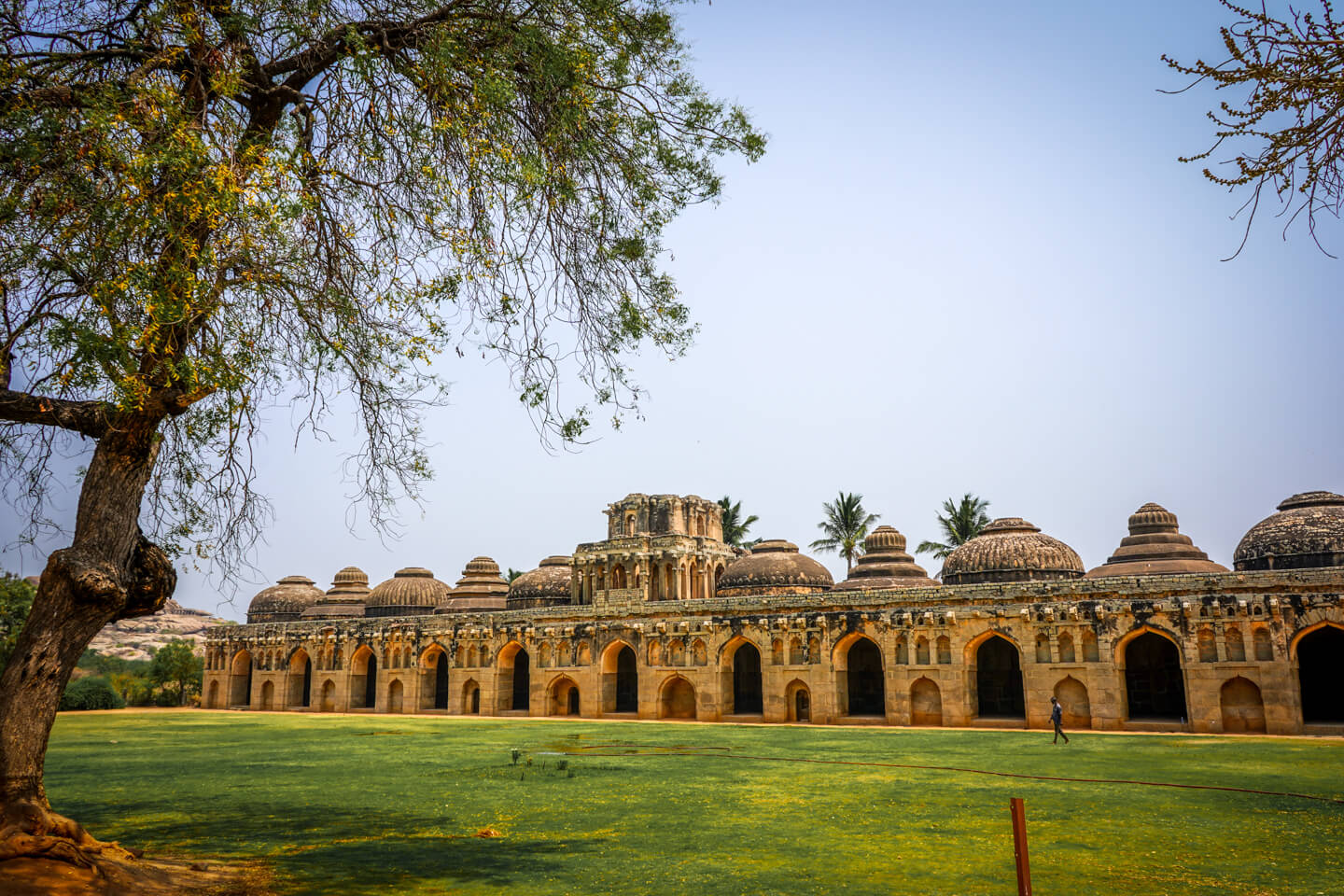
Really it’s a fantastic blog, I’ll definitely visit those places one day. Good work, Keep going.
Thank you. Hope you do 🙂
A very interesting blog about the Hampi places, very impressive. We are offering the eco-friendly tented accommodations and attentive yet discreet service allows guests to truly unwind in comfort amidst the serenity of the Evolveback Hampi Resort.